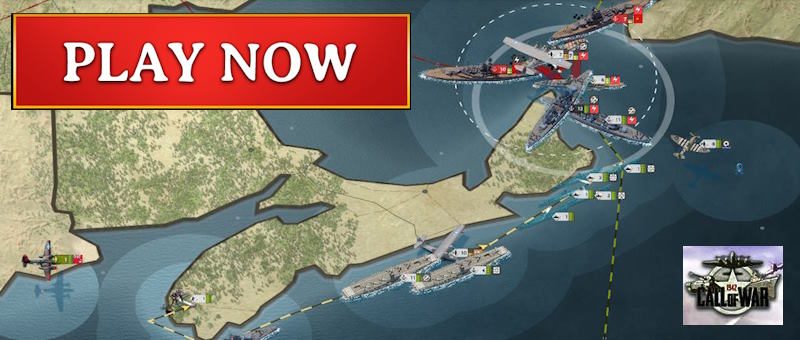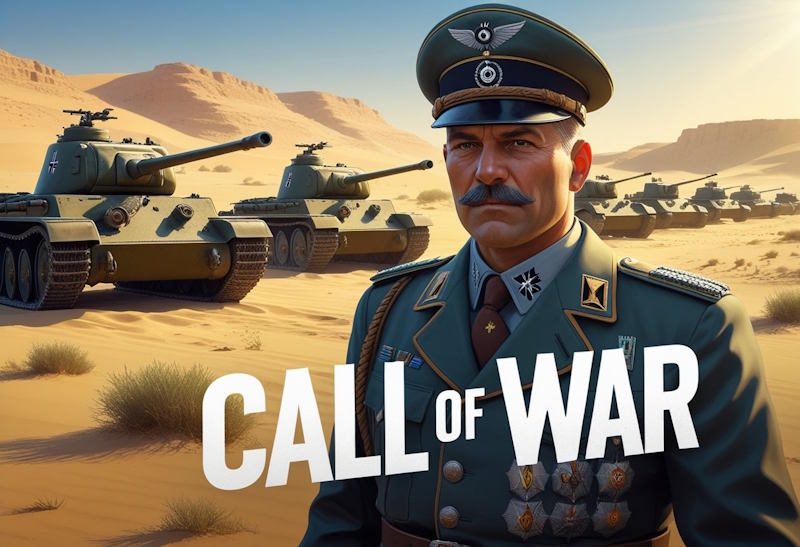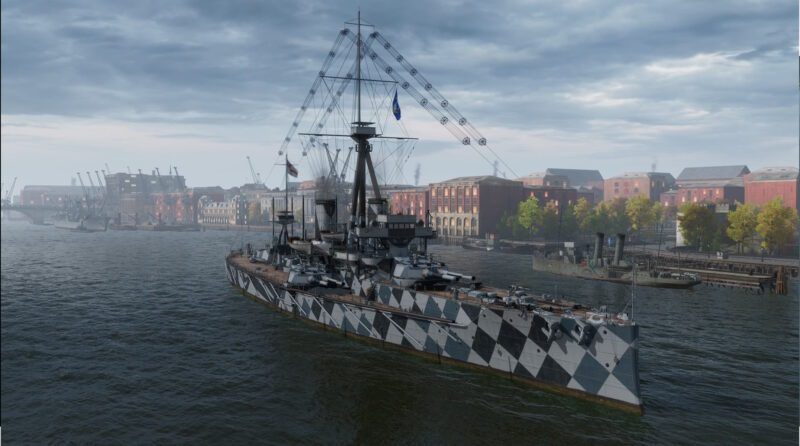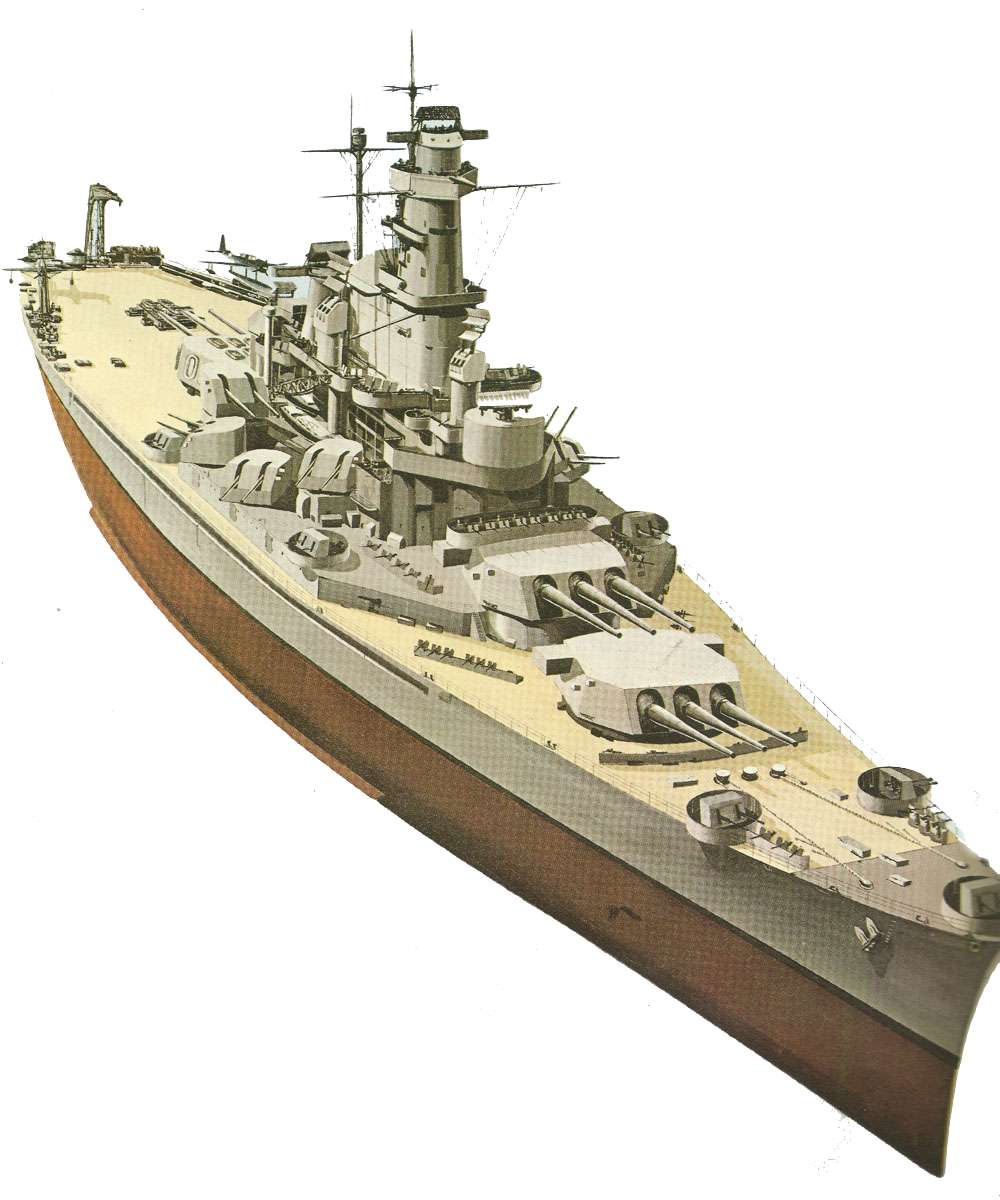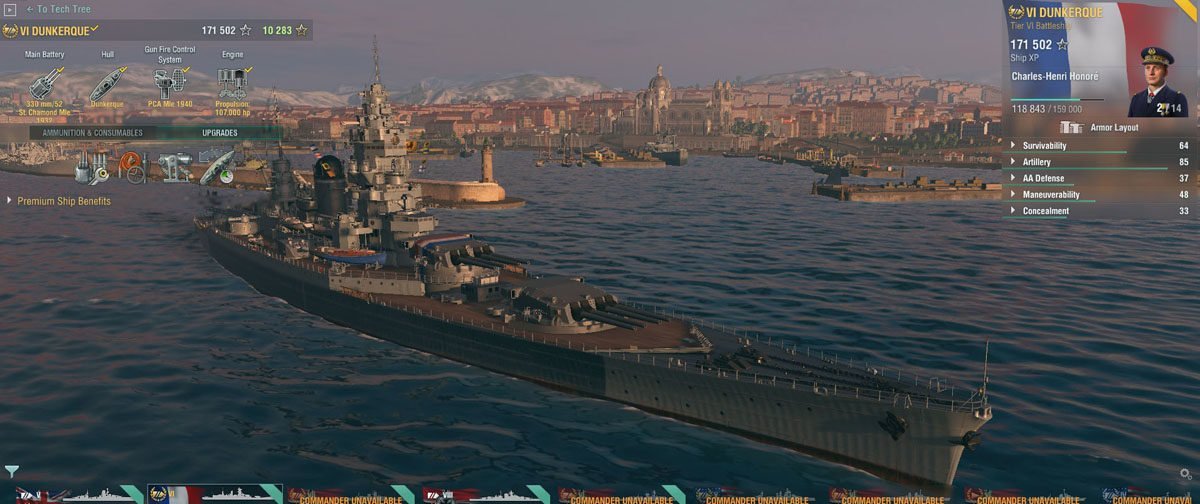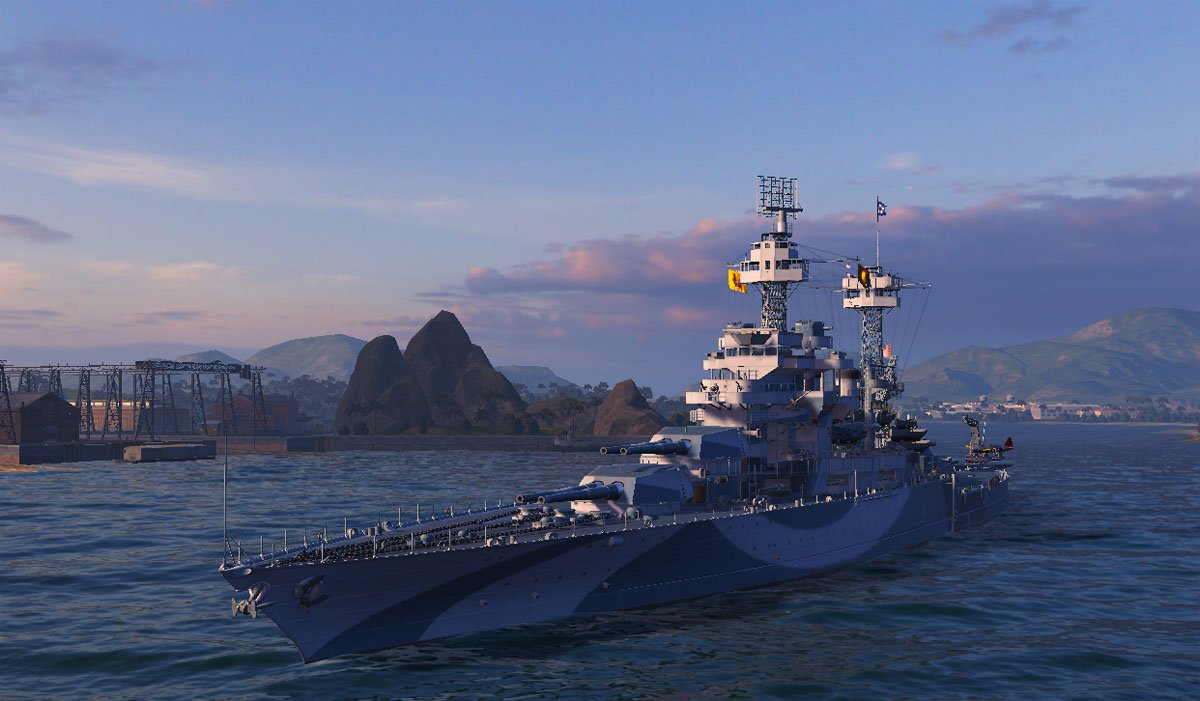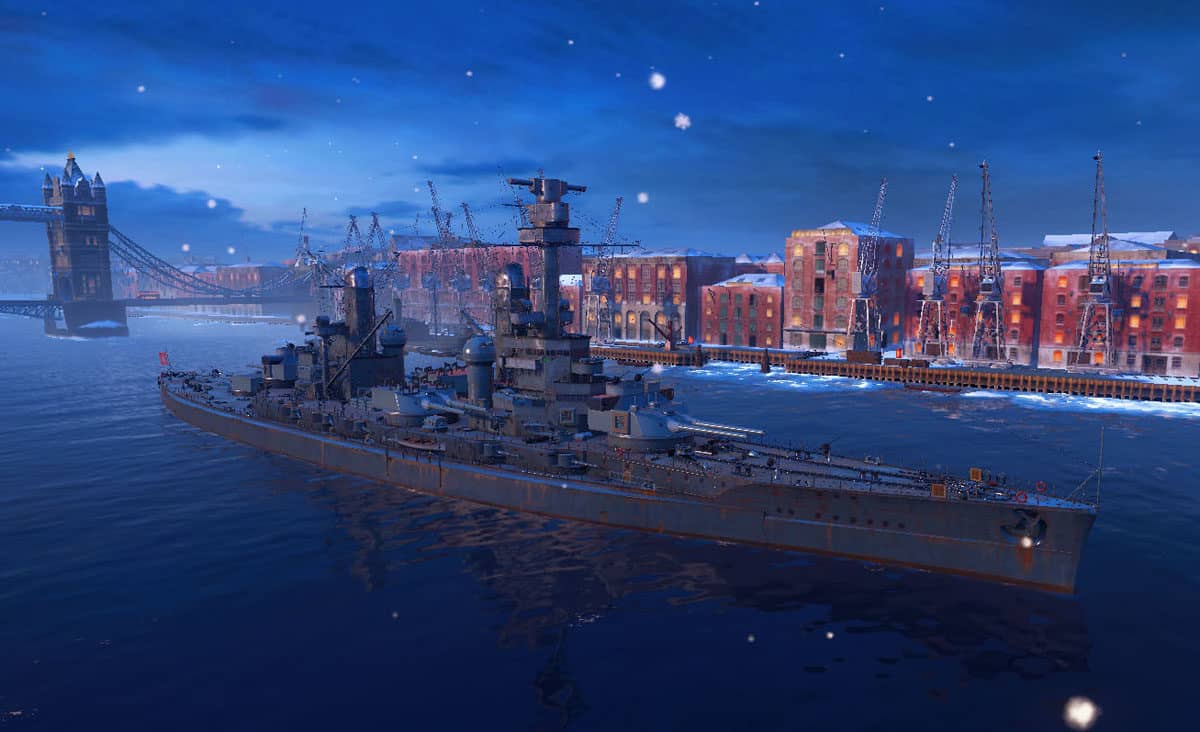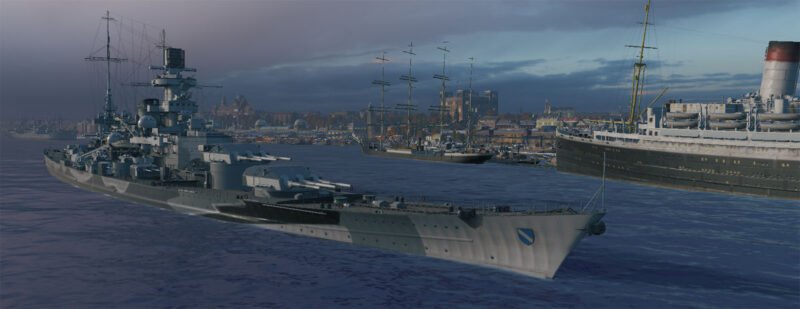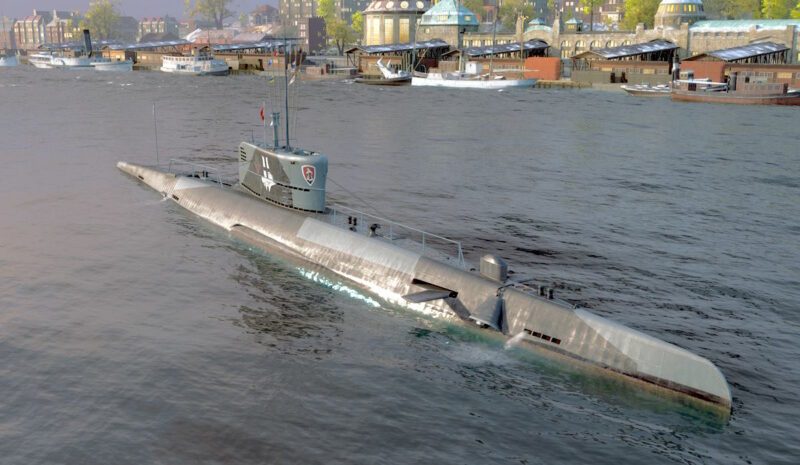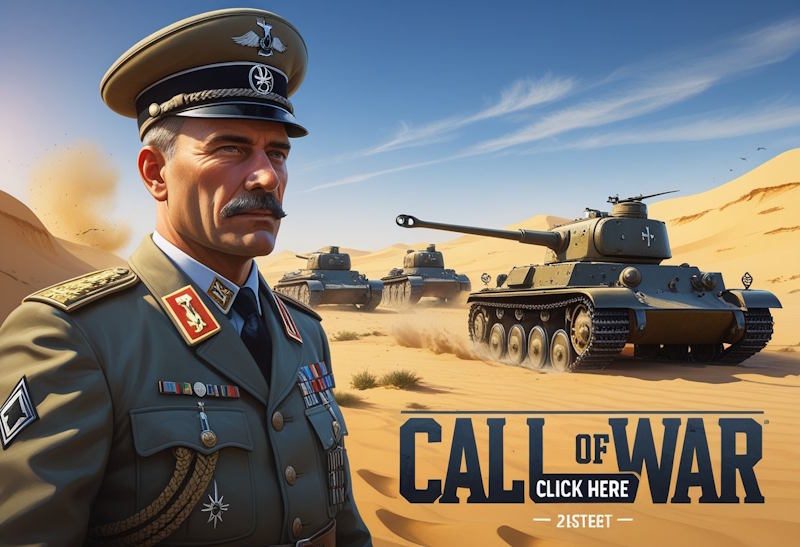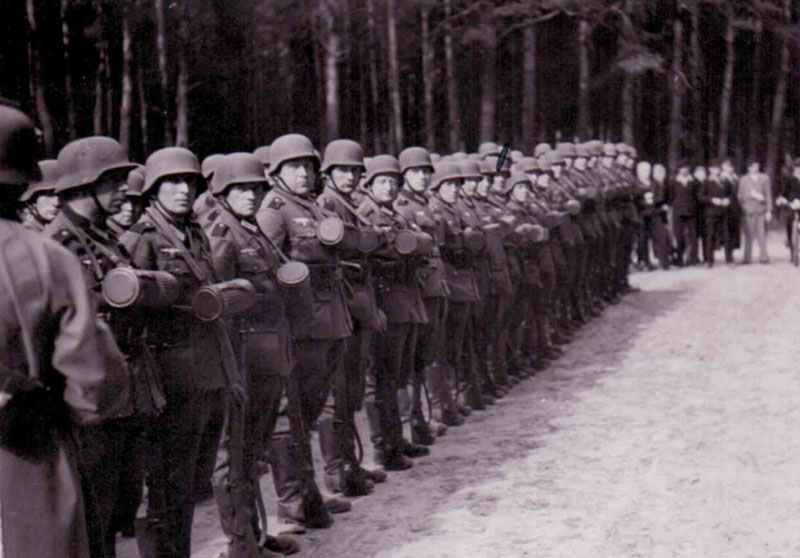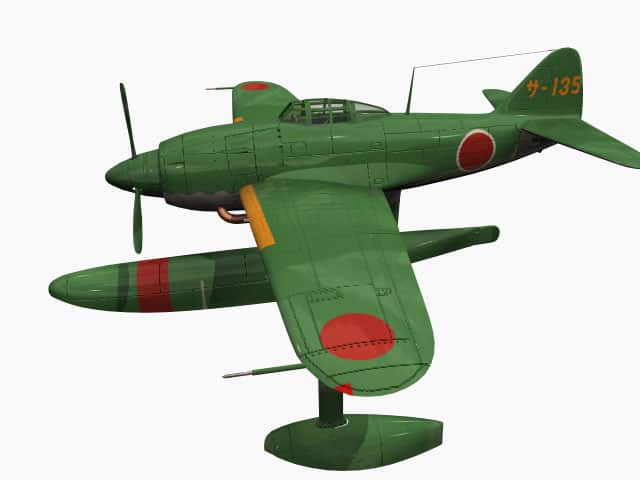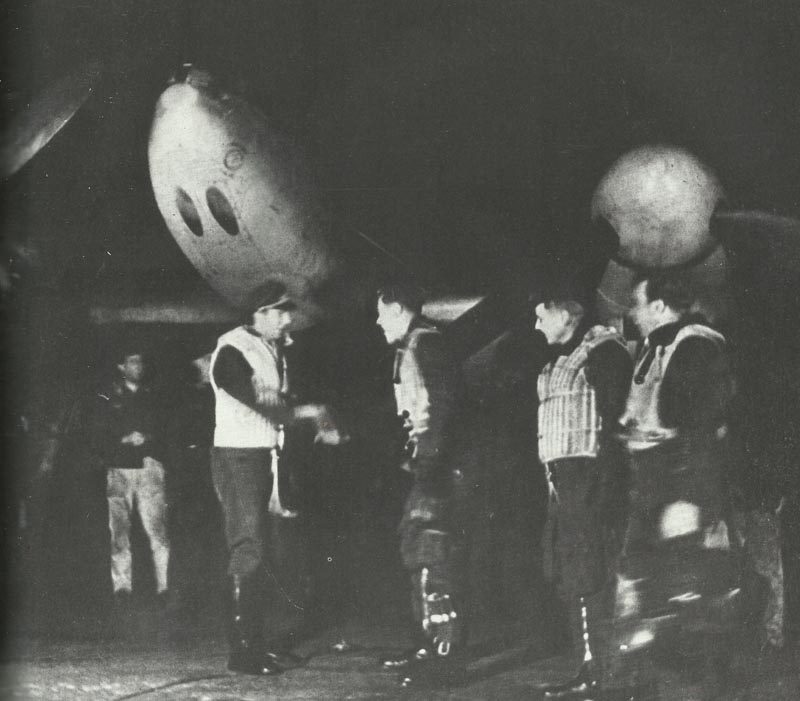World of Warships: Japanese premium battleship Mutsu of the Nagato class and her history and specifications from Second World War.
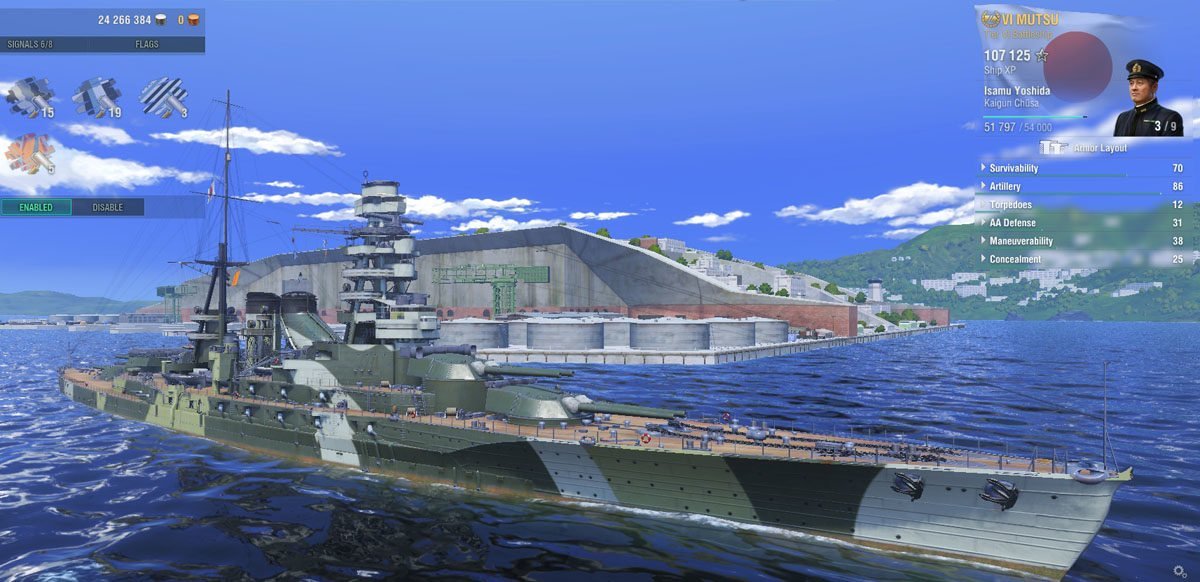
Japanese Nagato-class battleships
Table of Contents
The Nagato-class battleships were a pair of dreadnought battleships built for the Imperial Japanese Navy (IJN) during the 1910s. The two ships of the class were Nagato and Mutsu, which were named after ancient Japanese provinces.
Overview Nagato-class battleships
Armament: The main battery consisted of eight 41 cm (16.1 inch) guns in four twin turrets, two forward and two aft. They also carried a secondary armament of twenty 14 cm (5.5 inch) guns and various smaller caliber weapons.
Armor: The ships had a main belt armor of 305 mm (12 inches) and deck armor of 69 mm (2.7 inches).
Propulsion: The Nagato-class battleships were powered by four Gihon geared steam turbines, each driving one propeller shaft, with a total output of 80,000 shaft horsepower. This allowed a maximum speed of around 26.5 knots (49.1 km/h; 30.5 mph).
Size: The ships had a length of 215.8 meters (708 feet), a beam of 29.02 meters (95.2 feet), and a draft of 9.08 meters (29.8 feet).
Modernization: Both ships underwent significant modernization in the 1930s, which improved their speed, armor, and anti-aircraft capabilities.
The Nagato and Mutsu served as flagships of the Combined Fleet for much of their careers. They participated in the Second Sino-Japanese War and World War II. Nagato was present at the Japanese surrender in August 1945 and was later sunk as a target during the Operation Crossroads nuclear tests in 1946. Mutsu sank in 1943 after an internal explosion at anchor, with the loss of 1,121 crew members.
Battleship Mutsu in World of Warships
The battleship Mutsu belonged to the Nagato class and is placed on the rank VI of the Japanese tech tree in World of Warships. At the same rank, the free-to-play Japanese battleship Fuso is weaker and the class ship Nagato is only to be ranked on VII.
After explaining the gameplay principle of World of Warships and the tactical mission already in the review of the German battleship Kaiser in WoWs from World War One, here is a difference worth mentioning: the large fire range and the enormous effect of the slower shooting eight 16-inch guns of the Mutsu. In general, the use of armor-piercing shells is sufficient for almost all encountered enemies and at a cruising angle of about 30 degrees to the targets all guns can be fired in one salvo and the Mutsu offers only a small target.
Why a premium ship?
In World of Warships as well as in War Thunder numerous, so-called premium models, are available. Here, of course, they are warships, and they come from different classes, such as destroyers, cruisers, battleships and even aircraft carriers.
They are therefore unique as ‘premium’ because they can not be unlocked in the ordinary way in the game by advances in the ship’s research tree. They can only be bought against Real currency or sometimes won at competitions within the game.
The Japanese premium ships are listed here in the ship’s research tree on the right with yellow names. The Mutsu can be found in the second column from the right as the third ship from the top to rank VI.
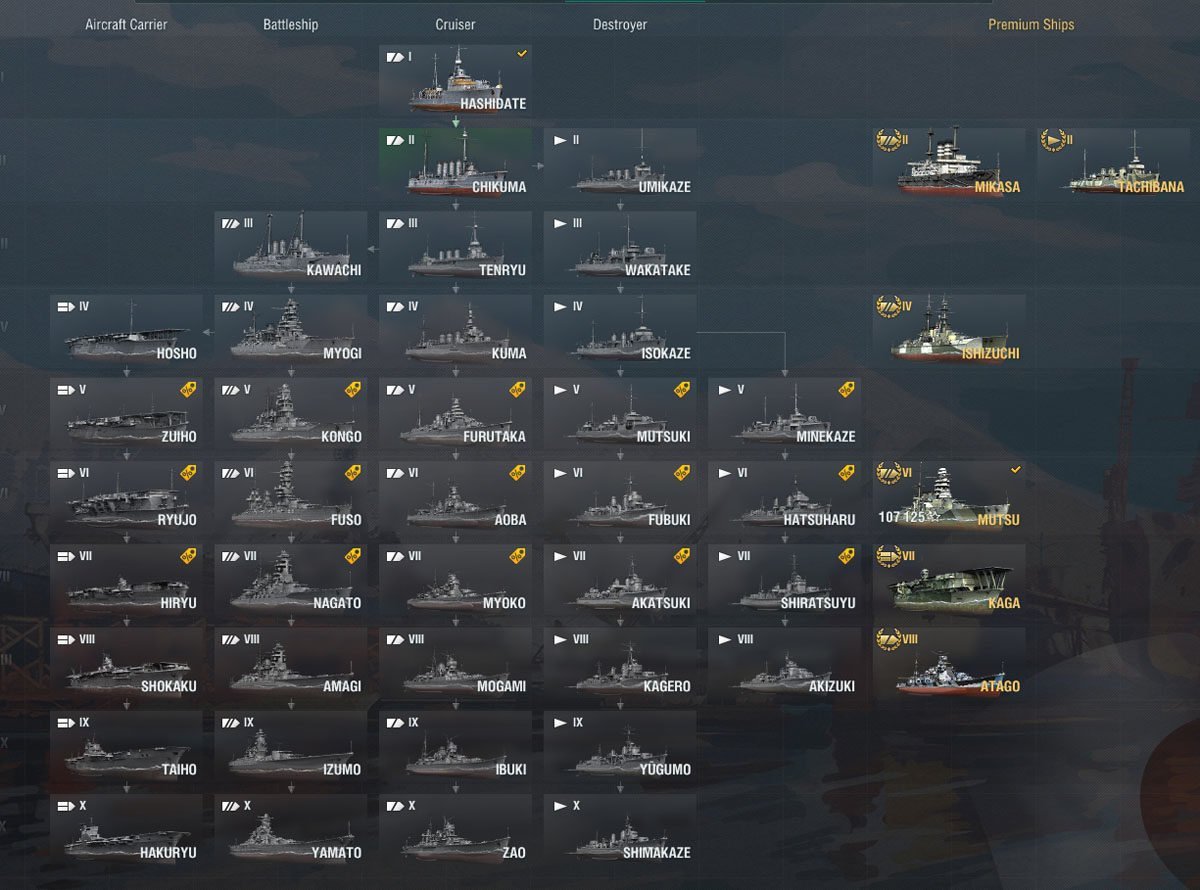
Unlike free-to-play ships, they are fully developed but often have worse statistical values than their freely playable counterparts. In the case of the Mutsu, however, this one rank lower than the slightly better, free and additionally modernized class ship Nagato and thus meets weaker opponents.
Not every player has every premium ship, so that in the battle you are in a bit more unique and special.
But above all, premium ships have some other advantages:
So the repair costs and the purchase of new ammunition after the battle are more favorable than with the usual ships and one gets more ‘in-game currency’. This gives you more money to equip your ships and buy newly researched ships.
In addition, the captains of the premium ships get more experience points in the battle. Incidentally, there are additional research points whose conversion to the purchase of not researched ships but cost real money, which probably only the least use of players.
Since the masses of the research points in WoWs are usually generated for the subsequent ship, and of course a premium ship does not have any, because it is located outside the ordinary ship’s research tree, it is progressing relatively slowly there. If you want to move forward faster and without additional real-money use, you must also use a regular standard ship in between.
In spite of everything, the premium ships in WoWs are generally not very superior and not a ‘pay-to-win’ model, though some are better than others. For a long time, the German battlecruiser Scharnhorst was considered the best premium ship, but the Mutsu can also be described as successful on the rank VI.
Not every premium ship is suitable for every type of player, and you should make sure that you have gained sufficient experience with the ship class before using the tactics and do not ‘buy’ too far up the rank, since here too, the mode of play changes and is characterized by greater fire ranges and stronger aircraft carriers and planes, which does not suit everyone.
Battleships are just for a less hectic style of firing over greater distances and are not so fast sunk, especially since they can be repaired during the battle – unless you run directly into a fan of torpedoes.
Video of an action with the battleship Mutsu in WoWs

History of the battleships Mutsu and Nagato
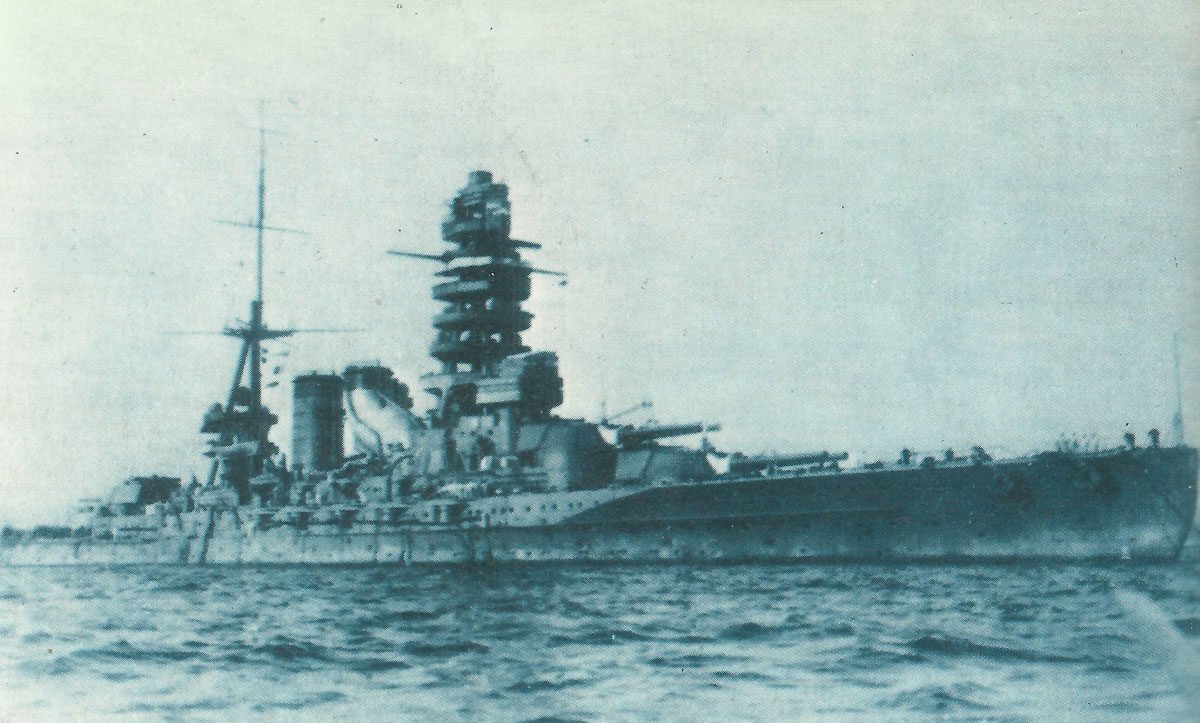
The Nagato class had as a model the fast battleships of the Queen Elizabeth class of the Royal Navy. Nagato and Mutsu were the first battleships with a main armament of 16-inch guns at a simultaneous high speed of over 25 knots.
The hull was based on the previous Japanese Hyuga class, but the 16-inch shells had a weight of 993 kg (2,192 lb) each over the 675 kg (1,490 lb) shells of 14-inch guns. For the same broadside weight thus the number of guns could be reduced.
After their commissioning in 1920-1921 they were thus the most powerful battleships of all nations, which had an excellent relationship between armament, armor protection, seaworthiness and speed. They were the first Japanese battleships with pagoda bridge masts.
They were modernized in the 1930s by a total renovation, where they received new machinery, extended the tail and torpedo bulges were installed. The front funnel was removed, and the pagoda mast was enlarged. For two 5.5-inch and four 2.75-inch guns, eight 5-inch guns and 20 one-inch guns were installed and the directional angle for the main guns could be raised from 13° to 43° degrees.
Until the completion of the Yamato, Nagato was from 1939 to 1941 the flagship of the Imperial Japanese Fleet and the barbette armor was increased to 500 mm (20 inch).
From 1941 to 1942 the ships were in the 1st Battle Division and participated in the Battle of the Midway Islands from June 4-6, 1942.
On December 25, Nagato was torpedoed and damaged by US submarine Skate near Truk. Mutsu sank in Hiroshima Bay on June 8, 1943, when an ammunition chamber exploded as the ship lay at anchor.
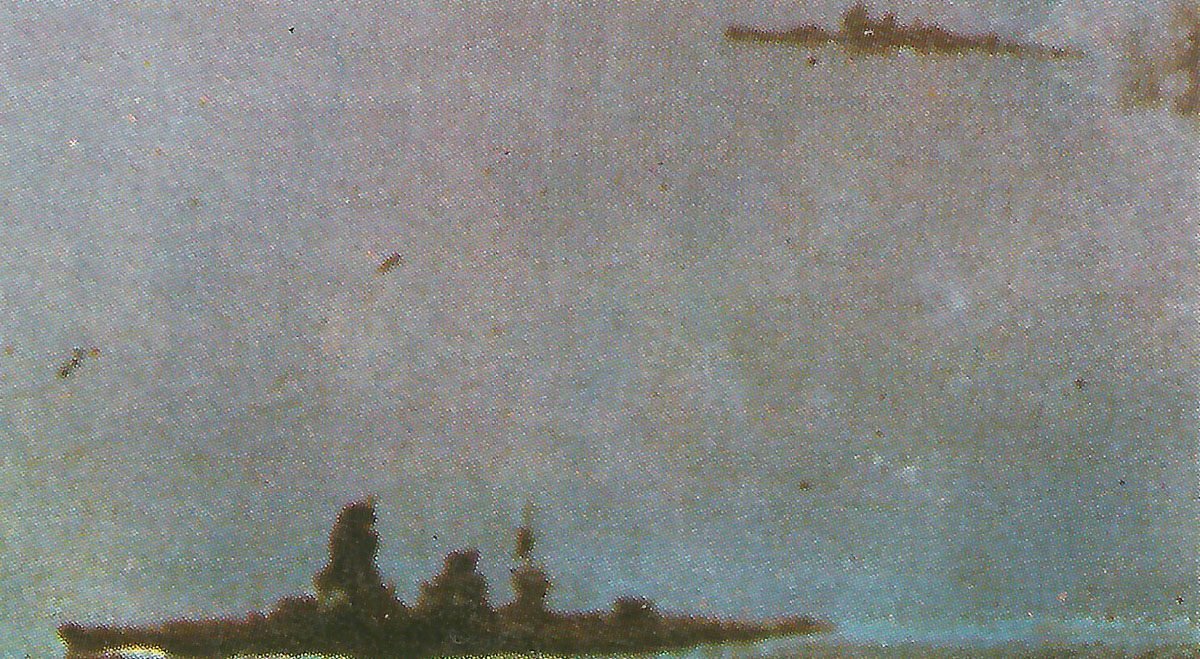
Nagato was refitted in 1944 with radar type 21 and 13 and for two 5.5 inch (ca. 14 cm) guns she received 78 x 25-mm anti-aircraft guns. In the Battle of the Leyte Gulf from October 20 to 26, 1944, she sank the American escort carrier Gambier Bay.
From January 1945, she was used in Japan as a floating air defense battery, with the funnel and the main mast were removed. On July 18, she was damaged in a US air strike, but survives the Second World War.
She was sunk only after being used as a target ship by the Americans in atomic bomb tests in Bikini Atoll on July 29, 1946.
Specification Nagato class
Specifications:
specification | original 1920 | after modernization 1936 |
|---|---|---|
Type | Battleship | |
Displacement | 32,721 t | 38,189 t |
Displacement (full loaded) | 38,499 t | 42,785 t |
Length | 660 ft | 660 ft |
Length at waterline | 700 ft | 725 ft |
Length over everything | 708 ft | 738 ft |
Beam | 95.1 ft | 113.5 ft |
Draught | 29.5 ft | 31.2 ft |
Boiler | Kampon (15 oil, 6 coal/oil) | Kampon (4 oil) |
Machinery | Kampon turbines with 4 shafts | Kampon geared turbines with 4 shafts |
Power | 80,000 hp | 82,000 hp |
Coal | 1,600 t | - |
Oil | 3,395 t | 5,600 t |
Speed | 26.75 kts | 25 kts |
Range | 5,500 sm at 15 kts | 8,650 sm at 16 kts |
Crew | 1,333 | 1,368 |
Armament:
specification | original 1920 | after modernization 1936 |
|---|---|---|
Main Armament | 8 x 16 inch L/45 guns | 8 x 16 inch L/45 guns |
Secondary Armament | 20 x 5.5 inch L/50 | 18 x 5.5 inch L/50, 8 x 5 inch |
Anti-aircraft guns | 4 x 3 inch | 20 x 25 mm |
Torpedo tubes | 8 x 21-inch | - |
Aircrafts | - | 3 |
Armor Protection:
specification | original 1920 | after modernization 1936 |
|---|---|---|
Side (belt) | 3-11.8 inch | 3-11.8 inch |
Side (ends) | 3.9-7.9 inch | 3.9-7.9 inch |
Back deck | 1 inch | 2.5 inch |
Main deck | 1.73 inch | 1.73-2.72 inch |
Lower deck | 2-3 inch | 2-3 inch |
Main artillery | 14 inch | 14 inch |
Babette | 11.8 inch | 11.8 inch (20 inch 1941) |
Casemates | 0.75-1 inch | 0.75-1 inch |
Service Statistics:
| Nagato | Mutsu | |
|---|---|---|
| Shipyard | State shipyard Kure | State shipyard Yokosuka |
| Laid down | August 28, 1917 | June 1, 1918 |
| Launched | November 9, 1919 | May 31, 1920 |
| Completed | November 25, 1920 | October 24, 1921 |
| Modernization | April 1934 - January 1936 | September 1934 - September 1936 |
| Fate | sunk July 29, 1946 as target ship | sunk June 8, 1943 after ammunition chamber explosion |
References and literature
Fighting Ships of the World (Antony Preston)
Kriegsschiffe von 1900 bis heute – Technik und Einsatz (Buch und Zeit Verlagsgesellschaft)
The Illustrated Directory of Warships from 1860 to the present day (David Miller)
Flotten des 2. Weltkrieges (Antony Preston)
Kriegsschiffe 1939-45 (Heyne-Bildpaperback)
The Encyclopedia of Weapons of World War II (Chris Bishop)


